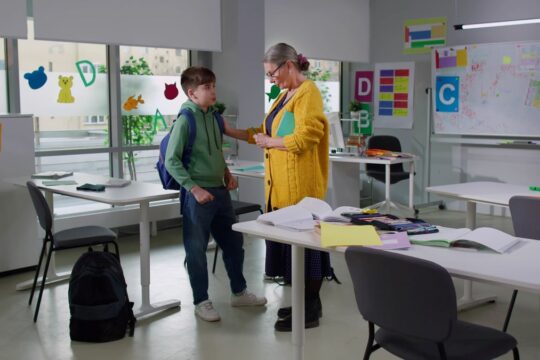Whether a student is constantly interrupting their teacher’s lesson or quietly texting in class, any type of disruptive behavior can throw a wrench into the lesson plan. Managing these behaviors can be difficult and feel overwhelming.
The key is to understand why this behavior is occurring, learn how to respond to it properly and create an environment that minimizes any classroom disruptions in the first place.
Understanding the Roots of Disruptive Behavior
Disruptive behavior doesn’t come out of nowhere, it’s often a signal that something deeper is going on. A student might be acting out due to learning challenges, or difficulties at home.
Others may simply lack the skills to regulate their emotions or follow classroom expectations. By digging into the “why” behind a behavior, you’re better equipped to address it effectively.
For example, a student who constantly interrupts might be seeking attention because they feel they are being overlooked.
On the other hand, a defiant student might be struggling with frustration over academic challenges they don’t know how to articulate. Observing patterns and having open conversations with students can provide insights that help you tailor your approach so all students will feel valued and understood.
Prevention Strategies
The best way to address disruptive behavior is to prevent it from happening in the first place. Here are some practical strategies to set the stage for a positive and productive classroom.
Clearly Define Your Expectations
Clearly state your expectations that you have for students from day one. They need to understand that with every unwanted behavior comes a consequence.
Write out any expectations that you have and visibly post them somewhere in the classroom where all students can see them.
These expectations can be something as simple as raising your hand before speaking, not texting in class, or always being prepared for class; to something more complex like no fighting in class.
Once your expectations are clearly stated and written out, students are expected to follow them, or they will be reprimanded.
Build Meaningful Relationships with Students
When students feel seen, valued, and respected, they’re more likely to engage positively. Take time to connect with your students individually. For instance, each day spend a few minutes to just get to your students, just a quick check-in or a simple compliment can go a long way.
Maintain a Routine
Having a classroom routine that students must follow every day can help combat those irritating classroom disruptions.
Children tend to get uneasy when they don’t know what they will be doing next. If you know that you will be straying from your daily routine then make sure that you write exactly what you will be doing on the front board, so students can have a reference throughout the
Keep Students Engaged
Keep lessons dynamic and interactive to reduce the temptation for off-task behavior. Incorporate group work, hands-on activities, and real-world connections to keep students invested in their learning. The more students are engaged in the classroom, the less likely they will be tempted to be disruptive.
Avoid Over-Spending Time with Disruptive Students
Oftentimes teachers focus a lot of their attention on the disruptive students instead of focusing on the rest of the class. Let your rules speak for you and do not give these students any extra attention. When you indulge in their need for attention you are only hurting the student.
Make sure that you enforce the same rules for all students so that the disruptive students can see that they are being treated the same as everyone else.
Eventually, the student will appreciate being treated the same and want to be a contributing member of the class and not an outcast who gets into trouble.
Intervention Techniques
Even with prevention strategies in place, disruptive behaviors will still happen. When they do, it’s important to address them in a firm and fair way.
Stay Calm: Your reaction sets the tone. A calm and composed demeanor can help to de-escalate situations and keep the focus on problem-solving rather than punishment.
Provide Choices: Giving students a sense of control can be empowering. Consider giving students a choice board where they get to choose from a list of activities instead of telling them what they will be doing.
Follow Through with Consequences: Consistency is key. If a consequence is necessary, ensure it’s appropriate. Explain the reasoning behind it so the student understands the connection between their behavior and the outcome. Remember, always stay calm.
Use Non-Verbal Cues: Sometimes, a simple look or hand signal is enough to remind a student of expectations without interrupting the flow of your lesson. Consider coming up with a classroom gesture that reminds students when they see this gesture it’s time to get focused and get to work.
Addressing Specific Types of Disruptive Behavior
Different behaviors require different approaches. Here are a few common scenarios and tips for handling them.
Chronic Talking
Engage talkative students by channeling their energy into discussions or leadership roles. If talking persists, try standing near the student, this can serve as a quiet reminder to stay on the task.
Off-Task Behavior
Sometimes students lose focus because they don’t understand the assignment. Check-in to see if they need clarification or adjust the task to better suit their learning style.
For students who may not feel comfortable asking clarifying questions in front of their peers, consider keeping green/red cards on each student’s desk so that when students need help, they can flip their cards to red.
Attention-Seeking Behavior
Provide positive attention to desired behaviors rather than reinforcing negative ones. For example, praise a student for raising their hand instead of calling out. This will show students that you only pay attention to positive behavior, not negative behavior.
Physical Aggression
When it comes to physical aggression, remember safety comes first. Address the situation immediately by separating students if necessary and seeking support from school counselors or administrators.
Once the situation is under control, work with the student to understand the root cause and develop a plan to prevent future incidents.
Effectively managing disruptive behavior takes patience and practice.
By understanding the underlying causes, creating a proactive classroom environment, and using thoughtful intervention strategies, you can minimize disruptions and foster a space where all students can thrive.
Educators never stop learning; check out our available graduate degree programs to hone your skills and promote lifelong learning and academic excellence.




